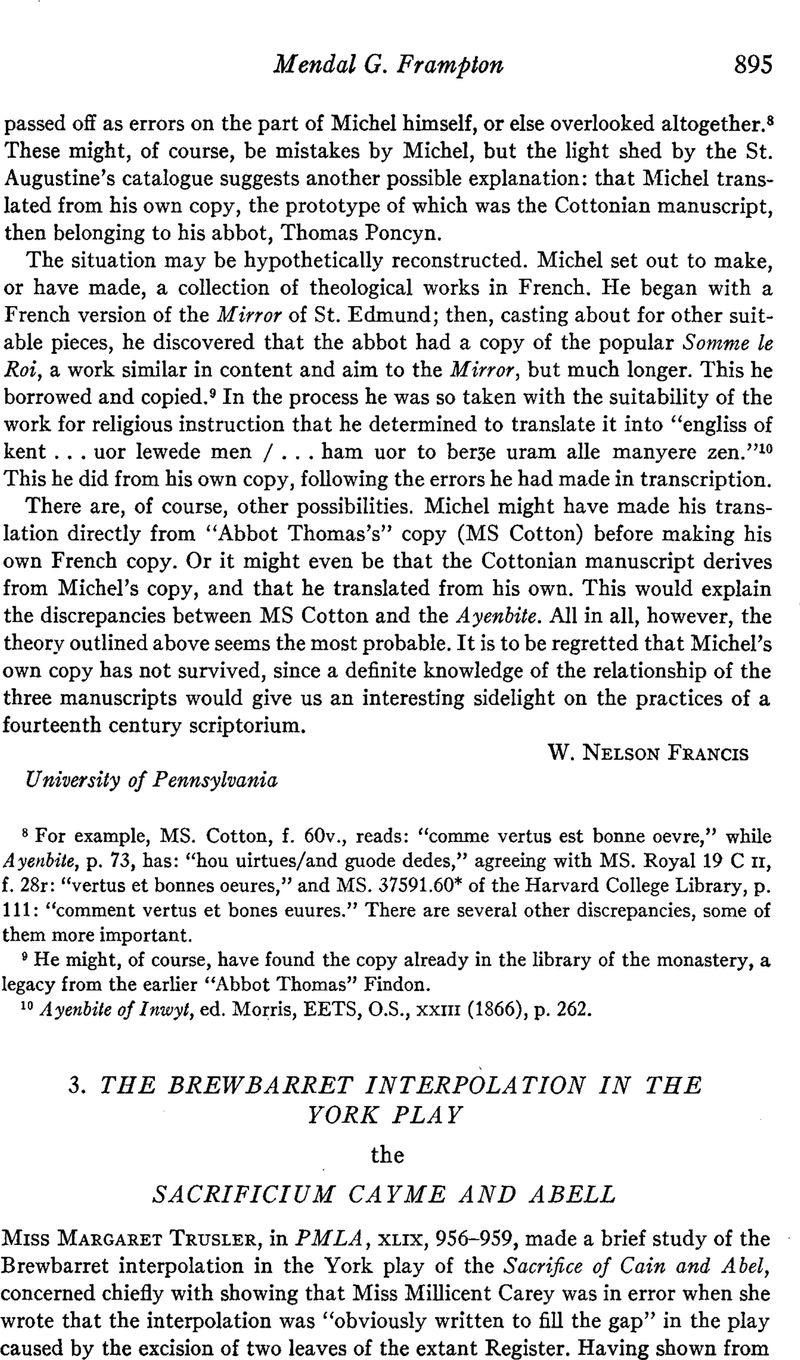No CrossRef data available.
Article contents
The Brewbarret Interpolation in the York Play the Sacrificium Cayme and Abell
Published online by Cambridge University Press: 02 December 2020
Abstract

- Type
- Comment and Criticism
- Information
- Copyright
- Copyright © Modern Language Association of America, 1937
References
1 For Mrs. McIntosh's position see Millicent Carey, “The Wakefield Group in the Towneley Cycle,” Hesperia, xi, 216.
2 Lucy Toulmin Smith, York Mystery Plays, p. 18, n. 1.
3 Ibid.,
4 Ibid., pp. xi, xii and xii, n.1.
5 Charles Mills Gayley, Plays of Our Forefathers, p. 154, n.l.
6 Millicent Carey, op. cit., p. 39.
7 Stanza no. 8, with which the original text resumes, may be restored if the tag words “this tyde” are placed one line earlier. Compare Play xxxii, lines 225–226, for a similar scribal transposition.
8 For similar poetic license see Play xxv, stanza 20.
9 These facts count against Professor Gayley's assumption that Brewbarret had a precursor in the original York play.
10 Cf. Smith, York Plays, pp. xi, xii, and xii, n.1.
11 I cannot agree with Miss Carey (op. cit., p. 217) that the presence of the word “Mr.” in line 73 of the play shows late authorship. It is more probably the unconscious writing of the scribe in 1558.
12 The list occupies folios 243v°–245 of the book.
13 Quoted from Lucy T. Smith, York Mystery Plays, p. xxiv.
14 Robert Davies, Extracts from the Municipal Records of the City of York, etc. (London, 1843), p. 235.
15 York Mem. Book, Surtees Soc., cxx, p. 155; Smith, York Plays, p. xxiv, n.1. Miss Smith conjectures the date 1410 in error.
16 Surtees Soc., cxxv, p. 171; Smith, op. cit., p. xxiv, n.1.
17 Quoted from York Plays, p. xxiv, n.1.—Miss Lyle seems to think that all four plays were included in the new one but I can find no evidence favoring this conclusion. See Original Identity of the York and Towneley Cycles, Univ. of Minn. diss. (June 1929), p. 105.
18 Play xxxiv, 11. 321–333; Play xxxv, 11. 289–300.
19 The contact is made in the middle of stanza 33. Note the double quatrains become the long Angel-Cain strophe by the mere addition of the cauda. The editing breaks down with stanza 35 where the cauda is corrupt. The strophe in scene 1, unmarked by Miss Smith, occupies lines 29–35.
20 Miss Lyle dates the second list c.1431 (Original Identity, p. 106). As the list contains the four plays which were forever excluded in 1422, as we have seen, I do not see how we can date the list after 1422. How much earlier than that date it was written we cannot know.
21 The second list is annotated in a later hand (York Plays, p. xxi, n.2.), with the words “Masons. Herod interrogans tres reges.” (Davies, op. cit., p. 234.) Someone also wrote the word “Masons” beside the word “Orfeuers,” or Goldsmiths, in Burton's first list. The transaction is thus abundantly verified. (See York Plays, p. xxi and n.2.)
22 The remaining three stanzas, written by Miss Smith without attempt to indicate them, run abababab4c2dddc4. The first has lost its cauda. The second is restored by writing line 44 properly as the last part of line 43. The third is restored by writing “His wille,” line 58, after “lawes” line 57, the alliteration upon “l.”
23 See York Plays, p. 18, n.1. and p. 433, n.1.
24 The bearing of this study upon the date of the flourishing of the Wakefield poet is obvious. For an extended discussion of the matter see my study, PMLA, l, 631–660.




